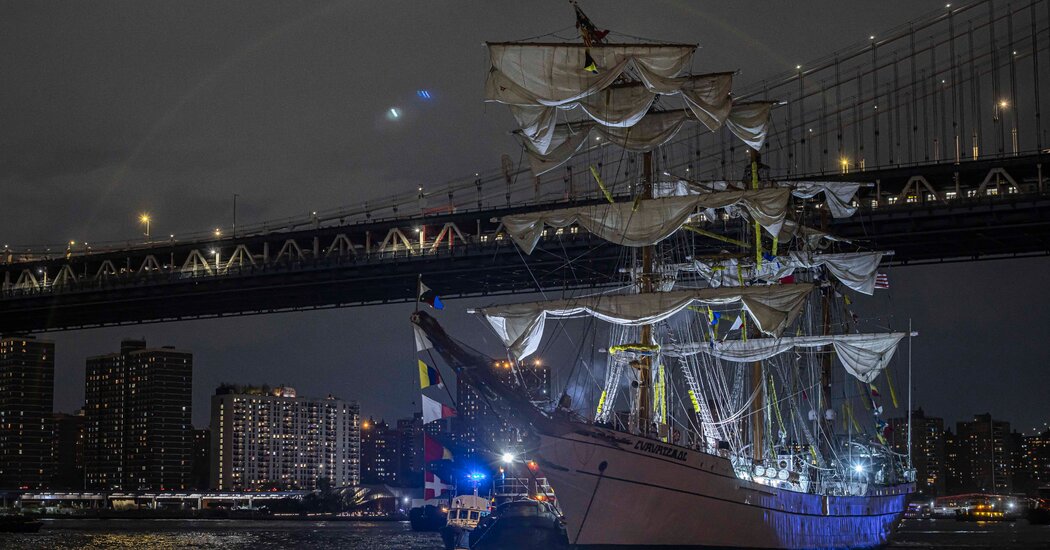The docking pilot boarded the Mexican naval ship, the Cuauhtémoc, shortly before the ship was to leave Pier 17 in the East River and head toward open sea. The pilot gave the command, and the ship, a tall sailing vessel with three masts, began to back away from the pier.
Once the Cuauhtémoc was clear of the slip, the docking pilot — whose job is to guide large ships from their berths to the harbor — gave a stop command. Then the pilot ordered the ship to proceed dead-slow-ahead — as slowly as possible, in a forward direction. Other commands followed, also ordering the ship forward, according to a federal report released Monday.
They seem to have had little effect. The ship instead continued to travel in the wrong direction, backward. And then it picked up speed, still traveling stern-first, before its masts slammed into the underside of the Brooklyn Bridge.
The crash on May 17 killed two crew members and injured 19 people. At the time of the crash, Mexican sailors were “manning the yards,” an old ritual in which sailors, high above deck, stand in rows along the horizontal spars on the masts.
The accident, captured on numerous cellphone videos, shocked the city: the sight of a huge sailing vessel colliding with the iconic bridge seemed almost like a disaster from another century.
The brief preliminary report released on Monday by the National Transportation Safety Board does not answer the central questions regarding the accident. It does not explain why the pilot’s orders had little effect, or shed light on the chain of events that left the ship traveling in the wrong direction. Nor does it explain how the vessel came to accelerate. It does not address whether there was a problem with the ship’s engines.
Those answers may not emerge for some time. The safety board’s final report could well take a year or two, officials have said. It will offer “final conclusions” and the most likely causes of the collision, a spokeswoman, Jennifer Gabris, said.
The brief report contained a detailed description of the scene on the Cuauhtémoc, a steel-hulled, three-masted barque about 300 feet long, as it departed Pier 17, destined for Iceland as part of a good-will tour.
The sea pilot, who would help the ship navigate New York Harbor, boarded shortly after 7 p.m. The docking pilot arrived at 7:45 p.m.
The six mooring lines that held the vessel were let go at 8:16 p.m. The docking pilot, on an open deck, gave commands to the Cuauhtémoc’s captain, who relayed them, in Spanish, to a crew member on the deck below. That crew member, in turn, relayed the commands to crew members inside the navigation bridge.
In addition to giving commands to the captain, the docking pilot was directing a tugboat, the Charles D. McAllister, which was initially positioned on the starboard side of the Mexican vessel, between it and the Brooklyn Bridge.
The docking pilot’s commands to the Cuauhtémoc — stop, dead-slow-ahead, ahead — did not succeed in switching the ship’s direction. But the report suggests that the pilot’s commands to the tugboat were to some degree followed.
After the Cuauhtémoc cleared the slip, the pilot directed the tugboat to position itself against the ship’s starboard bow, according to the report. The tugboat began pushing.
“The stern of the Cuauhtémoc began to swing toward the Brooklyn Bridge,” the report states.
By then the ship should have been traveling forward, out of the East River and into the harbor. But it was hurtling backward still.
The report describes how the docking pilot ordered the tugboat to stop pushing and maneuver toward the stern of the Cuauhtémoc. But by then the ship was accelerating toward the bridge. Its speed increased from 3.3 knots to 5.9 knots as it went backward.
Video footage shows the tug racing toward the ship’s stern in the moments before the collision. But it was too late.
The report said National Transportation Safety Board investigators had interviewed the two pilots and the tugboat captain, who were tested for drugs and alcohol. “All results were negative,” the report states.
In late May, the commander of the Mexican Navy, Adm. Raymundo Pedro Morales Ángeles, seemed to put some blame on the pilot who was advising the captain on how to navigate out of the channel.
“All the maneuvering that the ship did, from the moment it leaves the dock until it collided, is under the control of the pilot,” Admiral Morales Ángeles told reporters at a news conference. “Who decides how the maneuver is performed? The port pilot, precisely.”
But he later backtracked and said that Mexican authorities could not yet speculate whether the pilot had acted improperly.
The Mexican Navy is conducting its own investigation into the fatal accident, which President Claudia Sheinbaum said would explore several possible causes: a mechanical failure, the tugboat, human error. The report, she said, would not be made public for the time being.
Emiliano Rodríguez Mega contributed reporting.
Joseph Goldstein covers health care in New York for The Times, following years of criminal justice and police reporting.
The post How the Brooklyn Bridge Ship Disaster Unfolded appeared first on New York Times.




